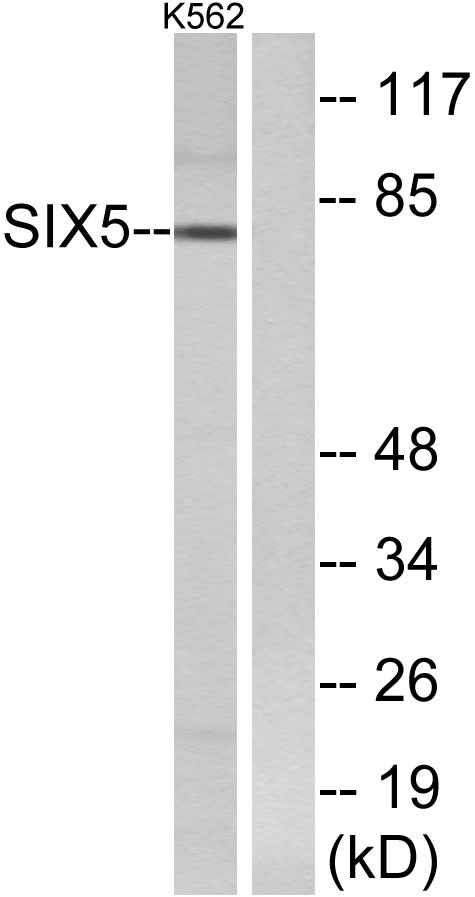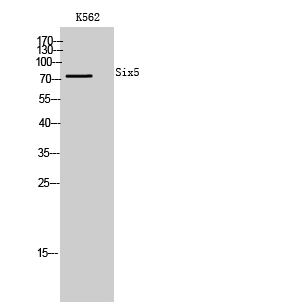产品名称
Six5 Rabbit Polyclonal Antibody
别名
SIX5; DMAHP; Homeobox protein SIX5; DM locus-associated homeodomain protein; Sine oculis homeobox homolog 5
蛋白名称
Homeobox protein SIX5
存储缓冲液
Liquid in PBS containing 50% glycerol, 0.5% BSA and 0.02% New type preservative N.
Human Gene Link
http://www.ncbi.nlm.nih.gov/sites/entrez?db=gene&term=147912
Human Swissprot No.
Q8N196
Human Swissprot Link
http://www.uniprot.org/uniprotkb/Q8N196/entry
Mouse Gene Link
http://www.ncbi.nlm.nih.gov/sites/entrez?db=gene&term=20475
Mouse Swissprot No.
P70178
Mouse Swissprot Link
http://www.uniprot.org/uniprot/P70178
免疫原
The antiserum was produced against synthesized peptide derived from human SIX5. AA range:201-250
特异性
Six5 Polyclonal Antibody detects endogenous levels of Six5 protein.
稀释度
WB 1:500-2000;IHC-p 1:50-300
宿主
Polyclonal, Rabbit,IgG
背景介绍
The protein encoded by this gene is a homeodomain-containing transcription factor that appears to function in the regulation of organogenesis. This gene is located downstream of the dystrophia myotonica-protein kinase gene. Mutations in this gene are a cause of branchiootorenal syndrome type 2. [provided by RefSeq, Jul 2009],
组织表达
Expressed in adult but not in fetal eyes. Found in corneal epithelium and endothelium, lens epithelium, ciliary body epithelia, cellular layers of the retina and the sclera.
细胞定位
Cytoplasm . Nucleus .
功能
caution:The region from 1 to 184 was deduced from the genomic sequence and ESTs.,developmental stage:At the begin of fourth week of development detected in cytoplasm of somite cells, and at the end of fourth week is accumulated in the nucleus. Between the sixth and eighth week of development detected in the nucleus of limb bud cells.,disease:Defects in SIX5 are the cause of branchiootorenal syndrome type 2 (BOR2) [MIM:610896]. BOR is an autosomal dominant disorder manifested by various combinations of preauricular pits, branchial fistulae or cysts, lacrimal duct stenosis, hearing loss, structural defects of the outer, middle, or inner ear, and renal dysplasia. Associated defects include asthenic habitus, long narrow facies, constricted palate, deep overbite, and myopia. Hearing loss may be due to mondini type cochlear defect and stapes fixation. Penetrance of BOR syndrome is high, although expressivity can be extremely variable.,function:Transcription factor that is thought to be involved in regulation of organogenesis. May be involved in determination and maintenance of retina formation. Binds a 5'-GGTGTCAG-3' motif present in the ARE regulatory element of ATP1A1. Binds a 5'-TCA[AG][AG]TTNC-3' motif present in the MEF3 element in the myogenin promoter, and in the IGFBP5 promoter (By similarity). Thought to be regulated by association with Dach and Eya proteins, and seems to be coactivated by EYA1, EYA2 and EYA3.,similarity:Belongs to the SIX/Sine oculis homeobox family.,similarity:Contains 1 homeobox DNA-binding domain.,subunit:Probably binds DNA dimer. Interacts with EYA3, and probably EYA1 and EYA2.,tissue specificity:Expressed in adult but not in fetal eyes. Found in corneal epithelium and endothelium, lens epithelium, ciliary body epithelia, cellular layers of the retina and the sclera.,
纯化
The antibody was affinity-purified from rabbit antiserum by affinity-chromatography using epitope-specific immunogen.


